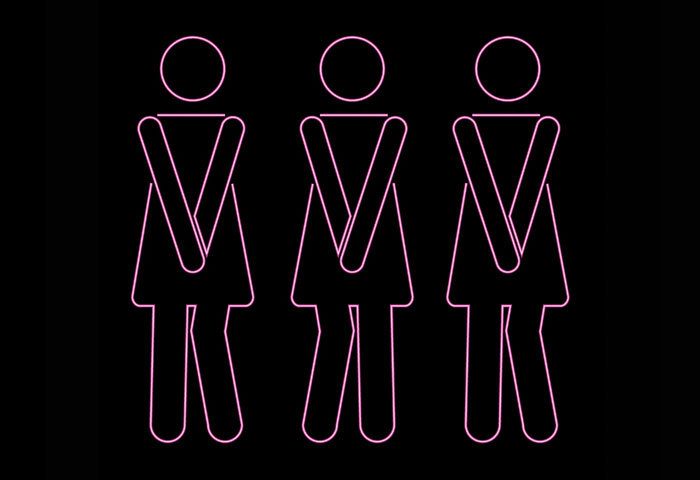Urinary Incontinence After Having a Baby

Wetting your pants as a new parent is common—but there are things you can do to help regain control.
Recently, a friend and I shared a laugh as we discussed a new fitness class that’s popular in our area. The fast-paced cardio dance class features upbeat music and instructors dressed like Lululemon ambassadors. The workout moves are fun and effective—but they’re also a disaster waiting to happen for many birthing parents. With a lot of jumping and bouncing (plyometrics, burpees, that kind of thing), there are more than a few opportunities for our pelvic floor muscles to give in to the stress and leak urine in public.
As my friend and I joked about wearing black, moisture-wicking pants and standing by the exit closest to the lavatory, I had thoughts: (1) I know we’re not the only birthing parents dealing with this shiz. (2) On the other hand, I have fitter-than-me parent friends who seem to have no problem jump-squatting, jumping-jacking, and double-rope-jumping from here until eternity. What’s the secret of their triumph over incontinence?
Why Do We Leak Urine After Giving Birth?
Urinary incontinence after delivery is relatively common, with 4 in 10 birthing parents experiencing symptoms. This loss of bladder control has everything to do with the pelvic floor muscles—the same group of muscles that work overtime to support the expanding uterus during pregnancy, only to be completely abused when it’s time for birth.
These muscles will stretch and strain—and maybe tear—during childbirth, leading to issues of incontinence that can begin immediately and/or wreak havoc in decades to come. When pelvic floor muscles are weak, the bladder leaks with every forceful movement. (Think jumping on a trampoline, working out, or even sneezing.)
With age and successive pregnancies, pelvic floor muscles grow increasingly weaker unless something is done to counteract their depletion. In some extreme cases, people assigned female at birth can suffer organ prolapse, where the bladder falls from its normal position down into the vagina, causing more problems and possibly requiring surgery.
What Can Be Done About Urinary Incontinence?
Good news: We do not have to resign ourselves to buying panty liners in bulk for the next 50 years! While some cases involve vaginal tearing or organ prolapse severe enough to require surgery (ask your OB to refer you to a urologist if you think you might fall into this category), most of us can take control of our pelvic floors independently with simple everyday practices.
Kegels are the most basic strengthening exercises for the pelvic floor. Named for the gynecologist who began to prescribe them in the 1940s, Kegel exercises are the repeated contracting and relaxing of the pelvic floor muscles. Kegels are safe to practice at any time but should be made a habit during pregnancy and reintroduced within a few days after an uncomplicated vaginal delivery.
To do Kegels, pay attention to the muscles in play when you go to the bathroom. The same muscles you use to stop and start the flow of urine are those we’re working with here. When you begin, you might only be able to tighten the pelvic floor muscles for a couple of seconds at a time, but practice several sets every day, and your endurance will build up so that you’re gradually holding stronger and longer before releasing.
Although Kegels are a great start, “Simply doing Kegels may not be enough,” says Lia G. Andrews, DAOM, LAc, author of The Postpartum Recovery Program. Welcome to the world of vaginal weight-lifting. (Who knew, right?) Andrews recommends strength training with modern vaginal weights, starting about four to six weeks after giving birth when the vaginal area has healed. With these weights, you’ll work toward lifting or clenching smaller objects.
If vaginal weights are uncomfortable for you, it’s better to stick with your Kegel exercises because any exercise is better than painful or no exercise at all. Plus, even though no one will see these fitness results, you stand to benefit in more ways than just better bladder control—pelvic floor exercises are said to increase sexual pleasure and deliver stronger orgasms, too.
Other Considerations for Improving Incontinence
“It’s important to understand that your pelvic floor muscles don’t stand alone,” stresses Michelle Ishio, BA, CPT, CAFS, a post-pregnancy rehab specialist in Los Angeles. “Your diaphragm, abdominal muscles, and back muscles contribute to the integrity of your pelvic floor muscles.”
Ishio’s rehabilitation methods include, first, maintaining a good neutral posture. When the pelvis is pushed back too far (like when wearing high heels) or jutted forward (like when you have a baby on your hip), you’re impeding pelvic floor recovery. Second, Ishio coaches, “Always contract your pelvic floor and abdominal muscles (simultaneously ) whenever you have short bouts of exertion. Doing this will help retrain your muscle reaction to exertion.” Your pelvic and abdominal muscles will improve hand-in-hand.
Nutrition plays a part, too. A patient carrying extra weight is more likely to have issues with incontinence and prolapse because of the added pressure that their pelvic floor muscles must bear. As your postpartum hormones come back into balance and you work to recover muscle strength, also remember to make dietary choices that will support your efforts (think nutrient-dense foods, anti-inflammatory foods, and lean proteins).
For many birthing parents, urinary incontinence is just part of the deal after having a baby. As you work to rebuild your pelvic floor muscle strength, you may find incontinence products helpful, such as incontinence pads or briefs for protecting your clothing from leaks. If you try these at-home treatments and still struggle with symptoms, be sure to talk to your health care provider and look into pelvic floor therapy for more specialized support.
Please note that some products listed are linked to affiliate websites and we may collect a small commission on your purchase.







